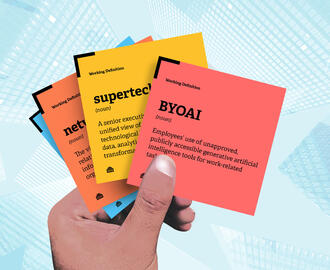Credit: Stephen Sauer
Today’s business leaders face an unprecedented amount of uncertainty, from technological disruption to economic and geopolitical volatility.
During a recent webinar, MIT faculty members offered guidance to leaders and organizations on how to effectively respond to these challenges and become future-ready, arguing that a “both/and” strategy works best: Companies must improve both their operational efficiency and their customer experience in order to thrive amid uncertainty.
“A future-ready company is one that is ambidextrous, that is innovating and pulling out costs at the same time,” said , director of the MIT Center for Information Systems Research.
Woerner was joined by MIT Sloan senior lecturer , as well as Mark Greeven and Howard Yu, professors at the International Institute for Management Development. The four are co-teachers of the Future-Ready Enterprise Academy program offered by MIT Sloan Executive Education and IMD.
Here are four tips from the panel on how to effectively respond in an unstable environment.
1. Embrace modularity
Complex organizations can thrive by breaking processes into modules that can be swapped in and out and reused for different purposes, not unlike Lego blocks. Future-ready companies “really think about their architecture so that they’re modular and agile, reusing components over and over again,” said Woerner, a principal research scientist at MIT Sloan.
A bank, for example, shouldn’t have a different way to onboard a customer for every single product it offers. “The question to ask as an organization is, do you need that kind of complexity?” Woerner said.
She advised companies to identify repetitive processes and then create modules that can be used in multiple situations, ideally using standardized data.
2. Encourage these types of leaders in your company
Isaacs said that successful organizations have three types of leaders:
- Entrepreneurial leaders, who exist within the lower and middle levels of a company and play a crucial role in generating ideas that align with the firm’s overall strategy.
- Architecting leaders, who are generally at the top level of leadership and design the game board of how modules are structured.
- Enabling leaders — superconnectors in the middle of a company’s hierarchy who are essential to ensuring that the module system works.
Research conducted by Isaacs and MIT’s Deborah Ancona and Elaine Backman on distributed leadership makes the case that the latter is highly underappreciated.
Enabling leaders are those who coach and connect entrepreneurial teams, Isaacs said: “They communicate up and down the organization what those teams are doing and help senior leaders understand where the innovation is coming from, and they help remove obstacles to innovation at the team level.”
3. Do more than experiment with artificial intelligence — embed it
It’s important that companies invest as much time and effort into embedding AI into their organizations as they do experimenting with it, Woerner said. CISR research has determined that AI unfolds within a company over four stages:
- Experiment and prepare.
- Build pilots and capabilities.
- Develop AI ways of working.
- Adopt AI-enabled processes and services.
Woerner said the third step is crucial. “Between Stage 2 and Stage 3 is where you have to start to commit,” she said. It’s where companies begin to figure out how AI is going to become a core competency and thus create AI-fueled ways of working.
“When you look at firm performance, the impact comes from moving from experiments to really embedding [AI]” to create organization-specific solutions, Woerner said.
4. Embrace both/and thinking to transform on two dimensions
Isaacs said that companies tend to see things in either/or terms — people or performance, margin or mission, centralized or decentralized, autonomy or alignment. “It’s very hard to hold on to both things and figure out how to create solutions that get the best of both,” she said.
Successful future-ready companies embrace both/and thinking to transform on two dimensions:
- Customer experience: Future-ready companies are customer-focused and purpose-focused. They create a great customer experience: They bring in customer feedback and amplify the voice of the customer through net promoter scores, design thinking, and sentiment analysis.
- Operational efficiency: Future-ready companies prioritize operational efficiency and innovation investment. They think about operational efficiency: They consider data a strategic asset and use it in decision-making and in AI. And they develop what Woerner calls “a platform mindset,” breaking down silos to distribute data, processes, and technologies across the organization.
“That dual both/and thinking is a really key leadership skill that we see folks who are future-ready being able to exhibit, and we teach practices in our course so that you can build your muscle around that,” Woerner said.

Future-Ready Enterprise Academy
In person at MIT Sloan
Register here




